
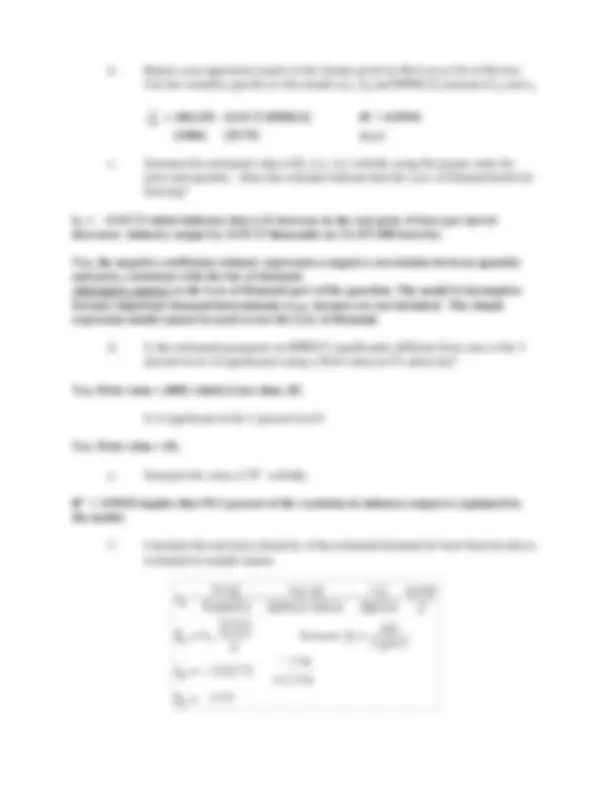
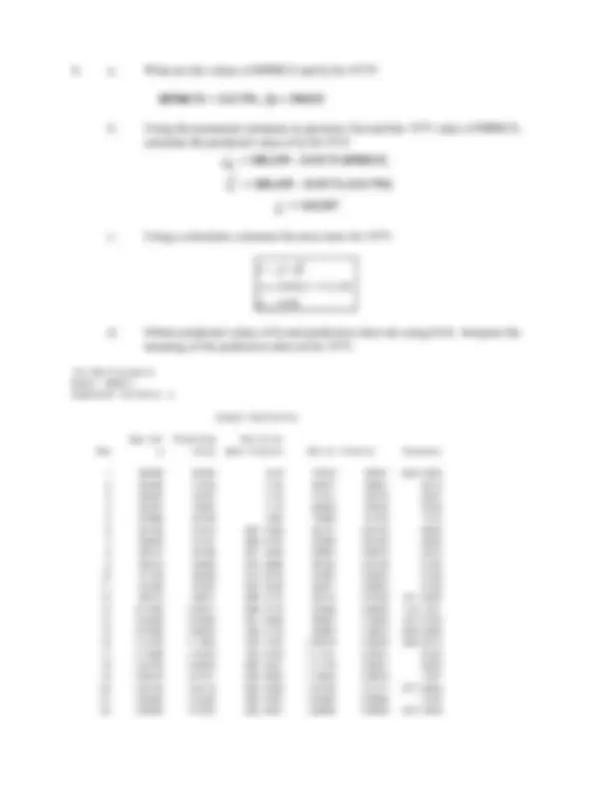
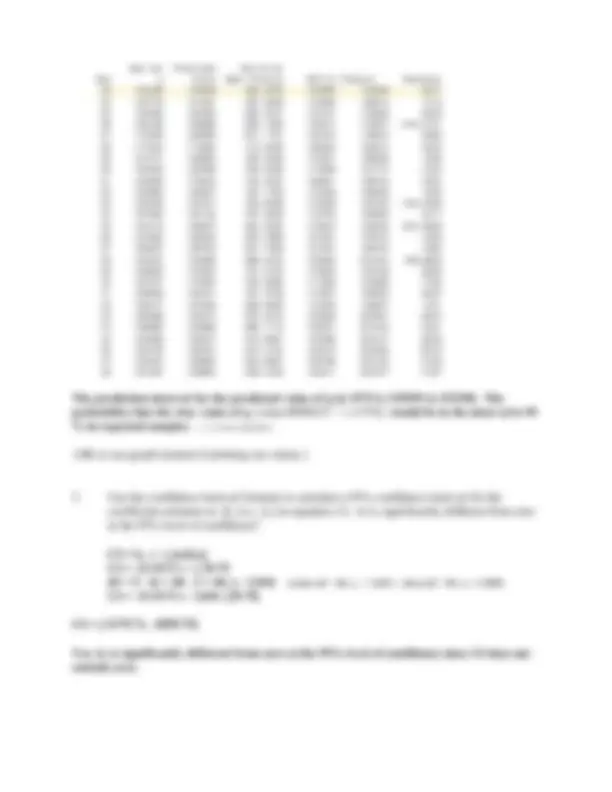
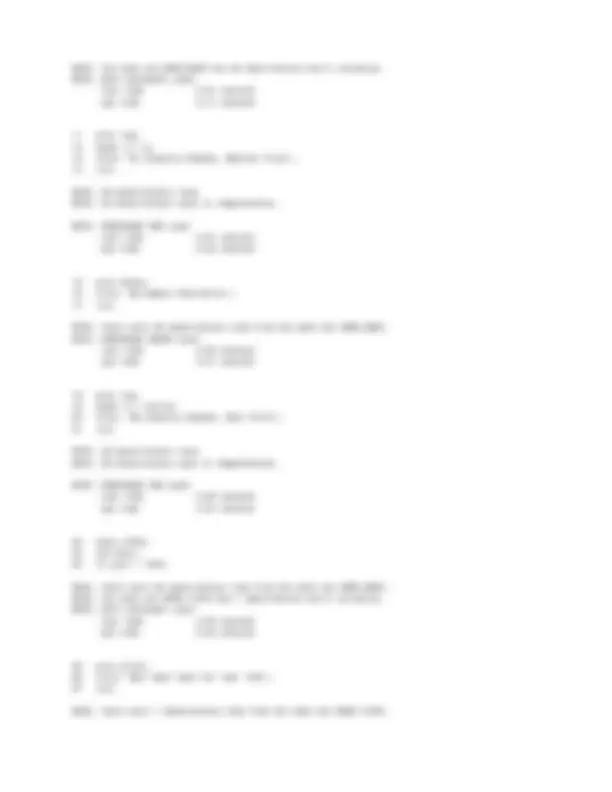
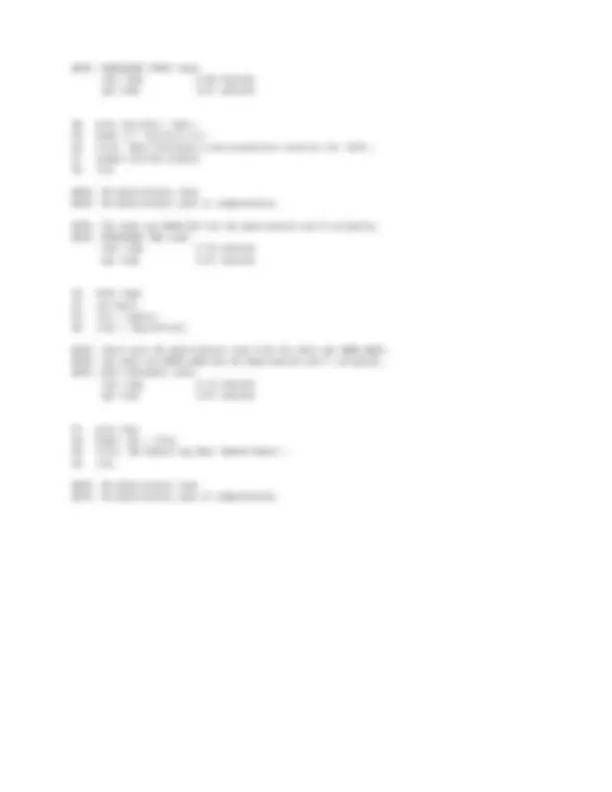


Study with the several resources on Docsity

Earn points by helping other students or get them with a premium plan


Prepare for your exams
Study with the several resources on Docsity

Earn points to download
Earn points by helping other students or get them with a premium plan
Community
Ask the community for help and clear up your study doubts
Discover the best universities in your country according to Docsity users
Free resources
Download our free guides on studying techniques, anxiety management strategies, and thesis advice from Docsity tutors
Material Type: Assignment; Class: INTRODUCTION TO ECONOMETRICS; Subject: Economics; University: Oregon State University; Term: Spring 2007;
Typology: Assignments
1 / 9

This page cannot be seen from the preview
Don't miss anything!






The REG Procedure
Model: MODEL
Dependent Variable: q
Analysis of Variance Sum of Mean
Source DF Squares Square F Value Pr > F
Model 1 69743090058 69743090058 192.54 <.
Error 46 16662773117 362234198
Corrected Total 47 86405863175
Root MSE 19032 R-Square 0.
Dependent Mean 146134 Adj R-Sq 0.
Coeff Var 13.
Parameter Estimates
Parameter Standard
Variable DF Estimate Error t Value Pr > |t|
Intercept 1 69605.8708098363 6161.55261582448 11.30 <.
p 1 931.519225845298 67.1329844830895 13.88 <.
The MEANS Procedure
Variable N Mean Std Dev Minimum Maximum ƒƒƒƒƒƒƒƒƒƒƒƒƒƒƒƒƒƒƒƒƒƒƒƒƒƒƒƒƒƒƒƒƒƒƒƒƒƒƒƒƒƒƒƒƒƒƒƒƒƒƒƒƒƒƒƒƒƒƒƒƒƒƒƒƒƒƒƒƒƒƒƒƒƒƒƒƒƒ year 48 1976.50 14.0000000 1953.00 2000. q 48 146134.25 42876.83 83488.00 197467. p 48 82.1543743 41.3532685 38.9325101 156. cpi 48 81.0743870 51.7395788 27.6822547 178. rprice 48 112.7598631 20.1364984 87.8699187 145. ƒƒƒƒƒƒƒƒƒƒƒƒƒƒƒƒƒƒƒƒƒƒƒƒƒƒƒƒƒƒƒƒƒƒƒƒƒƒƒƒƒƒƒƒƒƒƒƒƒƒƒƒƒƒƒƒƒƒƒƒƒƒƒƒƒƒƒƒƒƒƒƒƒƒƒƒƒƒ
The REG Procedure
Model: MODEL
Dependent Variable: q
Analysis of Variance
Sum of Mean
Source DF Squares Square F Value Pr > F
Model 1 85630225385 85630225385 5078.39 <.
Error 46 775637790 16861691
Corrected Total 47 86405863175
Root MSE 4106.29895 R-Square 0.
Dependent Mean 146134 Adj R-Sq 0.
Coeff Var 2.
Parameter Estimates
Parameter Standard
Variable DF Estimate Error t Value Pr > |t|
Intercept 1 385154.778165671 3406.03523077954 113.08 <.
rprice 1 -2119.7305635459 29.7452540506858 -71.26 <.
The REG Procedure Model: MODEL Dependent Variable: q
Output Statistics
Dep Var Predicted Std Error Obs q Value Mean Predict 95% CL Predict Residual
1 86209 87034 1019 78518 95551 -825. 2 83488 77276 1134 68701 85851 6212 3 85204 78707 1116 70141 87273 6497 4 85257 78467 1119 69900 87034 6790 5 84668 83196 1064 74658 91734 1472 6 84758 91613 967.7956 83121 100105 - 7 88006 91701 966.8187 83209 100192 - 8 88314 92186 961.4500 83697 100675 - 9 89473 94659 934.3666 86182 103136 - 10 91700 96436 915.2316 87967 104904 - 11 94338 97534 903.5446 89071 105997 - 12 99312 98871 889.4710 90413 107328 441. 13 101059 100917 868.2718 92469 109365 142. 14 104938 104530 831.9383 96097 112964 407. 15 107638 108224 796.4179 99805 116644 -586. 16 112190 111923 762.7273 103516 120330 266. 17 117066 119516 700.5755 111131 127901 - 18 122750 125550 659.3351 117178 133921 - 19 128318 127311 648.8853 118943 135679 1007 20 132740 133118 620.2008 124758 141477 -377. 21 139600 144335 593.2307 135984 152686 - 22 146850 147257 592.9027 138906 155609 -407.
Dep Var Predicted Std Error Obs q Value Mean Predict 95% CL Predict Residual 23 150323 143946 593.4879 135595 152298 6377 24 152773 151561 597.5648 143208 159913 1212 25 159460 162465 635.4541 154101 170829 - 26 166169 166686 659.1299 158314 175057 -516. 27 172559 168569 671.1161 160194 176944 3990 28 177934 174684 715.3946 166294 183074 3250 29 181917 180628 765.2325 172221 189036 1289 30 182332 183356 790.0039 174939 191774 - 31 183809 178342 745.3497 169941 186742 5467 32 182682 180847 767.1790 172439 189256 1835 33 183046 183747 793.6338 175328 192165 -700. 34 187562 184145 797.3648 175725 192565 3417 35 187212 186975 824.4564 178544 195405 237. 36 187632 189532 849.7889 181091 197973 - 37 188057 189722 851.7058 181281 198164 - 38 193257 193088 886.2372 184632 201544 168. 39 188950 179045 751.3745 170642 187448 9905 40 187247 179464 755.0062 171060 187868 7783 41 188648 182441 781.5706 174027 190855 6207 42 188477 187226 826.9093 178795 195657 1251 43 186366 192010 875.0419 183558 200461 - 44 188685 192986 885.1715 184531 201442 - 45 190069 196277 919.9891 187806 204747 - 46 192478 198797 947.3134 190315 207280 - 47 195457 198650 945.6981 190168 207132 - 48 197467 198894 948.3748 190411 207377 -
NOTE: Copyright (c) 1999-2001 by SAS Institute Inc., Cary, NC, USA. NOTE: SAS (r) Proprietary Software Release 8.2 (TS2M0) Licensed to OREGON STATE UNIVERSITY-CAMPUSWIDE-T/R, Site 0009032001. NOTE: This session is executing on the WIN_PRO platform.
NOTE: SAS initialization used: real time 2.15 seconds cpu time 2.15 seconds
1 options ls =80 nocenter nonumber; 2 data beer; 3 infile 'C:\WINDOWS\SYSTEM32\beerdem.dat'; 4 input year q p cpi; 5 /Variable definitions: 6 p = nominal dollar price of beer per barrel 7 q = industry output (thousands of barrels) 8 cpi = consumer price index 9 ; 10 rprice = (p/cpi)100; *real price of beer;
NOTE: The infile 'C:\WINDOWS\SYSTEM32\beerdem.dat' is: File Name=C:\WINDOWS\SYSTEM32\beerdem.dat, RECFM=V,LRECL=
NOTE: 48 records were read from the infile 'C:\WINDOWS\SYSTEM32\beerdem.dat'. The minimum record length was 20. The maximum record length was 37.
NOTE: The data set WORK.BEER has 48 observations and 5 variables. NOTE: DATA statement used: real time 0.81 seconds cpu time 0.17 seconds
11 proc reg; 12 model q = p; 13 title 'Q1-Industry Demand, Nominal Price'; 14 run;
NOTE: 48 observations read. NOTE: 48 observations used in computations.
NOTE: PROCEDURE REG used: real time 0.81 seconds cpu time 0.23 seconds
15 proc means; 16 title 'Q2-Sample Statistics'; 17 run;
NOTE: There were 48 observations read from the data set WORK.BEER. NOTE: PROCEDURE MEANS used: real time 0.09 seconds cpu time 0.01 seconds
18 proc reg; 19 model q = rprice; 20 title 'Q3-Industry Demand, Real Price'; 21 run;
NOTE: 48 observations read. NOTE: 48 observations used in computations.
NOTE: PROCEDURE REG used: real time 0.09 seconds cpu time 0.04 seconds
22 data y1975; 23 set beer; 24 if year = 1975;
NOTE: There were 48 observations read from the data set WORK.BEER. NOTE: The data set WORK.Y1975 has 1 observations and 5 variables. NOTE: DATA statement used: real time 0.03 seconds cpu time 0.03 seconds
25 proc print; 26 title 'Q3c1 Beer Data for Year 1975'; 27 run;
NOTE: There were 1 observations read from the data set WORK.Y1975.